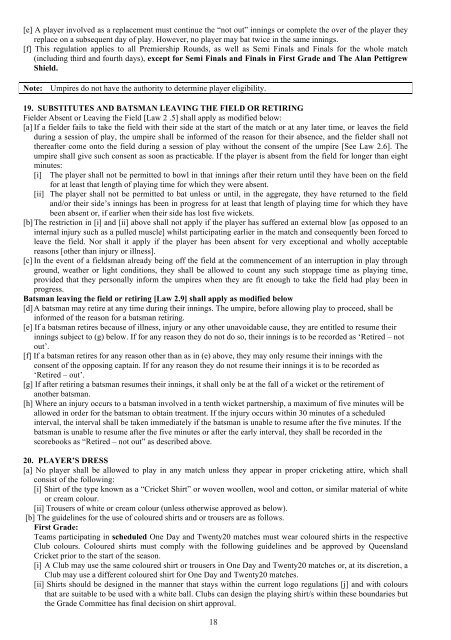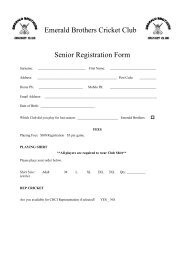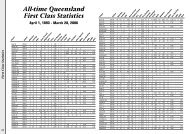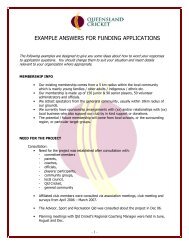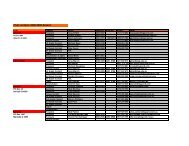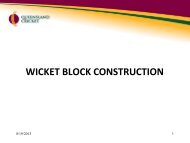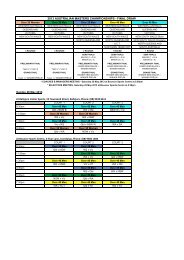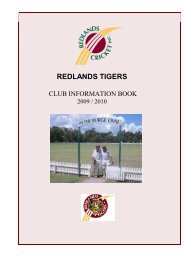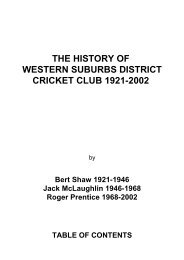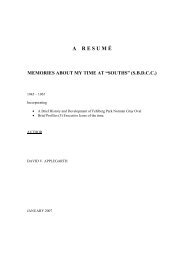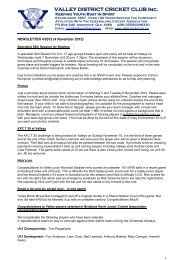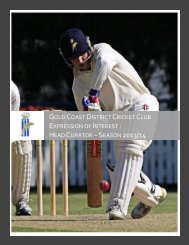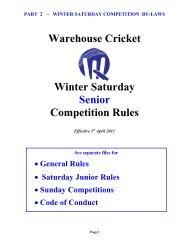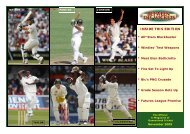2012 - 2013 PREMIER GR ADE HANDBOOK - Queensland Cricket
2012 - 2013 PREMIER GR ADE HANDBOOK - Queensland Cricket
2012 - 2013 PREMIER GR ADE HANDBOOK - Queensland Cricket
You also want an ePaper? Increase the reach of your titles
YUMPU automatically turns print PDFs into web optimized ePapers that Google loves.
[e] A player involved as a replacement must continue the “not out” innings or complete the over of the player they<br />
replace on a subsequent day of play. However, no player may bat twice in the same innings.<br />
[f] This regulation applies to all Premiership Rounds, as well as Semi Finals and Finals for the whole match<br />
(including third and fourth days), except for Semi Finals and Finals in First Grade and The Alan Pettigrew<br />
Shield.<br />
Note: Umpires do not have the authority to determine player eligibility.<br />
19. SUBSTITUTES AND BATSMAN LEAVING THE FIELD OR RETIRING<br />
Fielder Absent or Leaving the Field [Law 2 .5] shall apply as modified below:<br />
[a] If a fielder fails to take the field with their side at the start of the match or at any later time, or leaves the field<br />
during a session of play, the umpire shall be informed of the reason for their absence, and the fielder shall not<br />
thereafter come onto the field during a session of play without the consent of the umpire [See Law 2.6]. The<br />
umpire shall give such consent as soon as practicable. If the player is absent from the field for longer than eight<br />
minutes:<br />
[i] The player shall not be permitted to bowl in that innings after their return until they have been on the field<br />
for at least that length of playing time for which they were absent.<br />
[ii] The player shall not be permitted to bat unless or until, in the aggregate, they have returned to the field<br />
and/or their side’s innings has been in progress for at least that length of playing time for which they have<br />
been absent or, if earlier when their side has lost five wickets.<br />
[b] The restriction in [i] and [ii] above shall not apply if the player has suffered an external blow [as opposed to an<br />
internal injury such as a pulled muscle] whilst participating earlier in the match and consequently been forced to<br />
leave the field. Nor shall it apply if the player has been absent for very exceptional and wholly acceptable<br />
reasons [other than injury or illness].<br />
[c] In the event of a fieldsman already being off the field at the commencement of an interruption in play through<br />
ground, weather or light conditions, they shall be allowed to count any such stoppage time as playing time,<br />
provided that they personally inform the umpires when they are fit enough to take the field had play been in<br />
progress.<br />
Batsman leaving the field or retiring [Law 2.9] shall apply as modified below<br />
[d] A batsman may retire at any time during their innings. The umpire, before allowing play to proceed, shall be<br />
informed of the reason for a batsman retiring.<br />
[e] If a batsman retires because of illness, injury or any other unavoidable cause, they are entitled to resume their<br />
innings subject to (g) below. If for any reason they do not do so, their innings is to be recorded as ‘Retired – not<br />
out’.<br />
[f] If a batsman retires for any reason other than as in (e) above, they may only resume their innings with the<br />
consent of the opposing captain. If for any reason they do not resume their innings it is to be recorded as<br />
‘Retired – out’.<br />
[g] If after retiring a batsman resumes their innings, it shall only be at the fall of a wicket or the retirement of<br />
another batsman.<br />
[h] Where an injury occurs to a batsman involved in a tenth wicket partnership, a maximum of five minutes will be<br />
allowed in order for the batsman to obtain treatment. If the injury occurs within 30 minutes of a scheduled<br />
interval, the interval shall be taken immediately if the batsman is unable to resume after the five minutes. If the<br />
batsman is unable to resume after the five minutes or after the early interval, they shall be recorded in the<br />
scorebooks as “Retired – not out” as described above.<br />
20. PLAYER’S DRESS<br />
[a] No player shall be allowed to play in any match unless they appear in proper cricketing attire, which shall<br />
consist of the following:<br />
[i] Shirt of the type known as a “<strong>Cricket</strong> Shirt” or woven woollen, wool and cotton, or similar material of white<br />
or cream colour.<br />
[ii] Trousers of white or cream colour (unless otherwise approved as below).<br />
[b] The guidelines for the use of coloured shirts and or trousers are as follows.<br />
First Grade:<br />
Teams participating in scheduled One Day and Twenty20 matches must wear coloured shirts in the respective<br />
Club colours. Coloured shirts must comply with the following guidelines and be approved by <strong>Queensland</strong><br />
<strong>Cricket</strong> prior to the start of the season.<br />
[i] A Club may use the same coloured shirt or trousers in One Day and Twenty20 matches or, at its discretion, a<br />
Club may use a different coloured shirt for One Day and Twenty20 matches.<br />
[ii] Shirts should be designed in the manner that stays within the current logo regulations [j] and with colours<br />
that are suitable to be used with a white ball. Clubs can design the playing shirt/s within these boundaries but<br />
the Grade Committee has final decision on shirt approval.<br />
18


